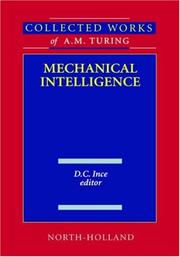| Listing 1 - 10 of 57666 | << page >> |
Sort by
|

ISBN: 0444880585 9780444880581 Year: 1992 Publisher: Amsterdam: North-Holland,
Abstract | Keywords | Export | Availability | Bookmark
 Loading...
Loading...Choose an application
- Reference Manager
- EndNote
- RefWorks (Direct export to RefWorks)
Periodical
ISSN: 18758452 09217126 Year: 1988 Publisher: [Amsterdam] : IOS Press
Abstract | Keywords | Export | Availability | Bookmark
 Loading...
Loading...Choose an application
- Reference Manager
- EndNote
- RefWorks (Direct export to RefWorks)
Book
ISBN: 1467364894 1467364886 1467364908 9781467364904 Year: 2013 Publisher: [Place of publication not identified] : Institute of Electrical and Electronics Engineers,
Abstract | Keywords | Export | Availability | Bookmark
 Loading...
Loading...Choose an application
- Reference Manager
- EndNote
- RefWorks (Direct export to RefWorks)
Book
ISBN: 1479903035 1479903027 1479903051 9781479903054 Year: 2013 Publisher: [Place of publication not identified] : Institute of Electrical and Electronics Engineers,
Abstract | Keywords | Export | Availability | Bookmark
 Loading...
Loading...Choose an application
- Reference Manager
- EndNote
- RefWorks (Direct export to RefWorks)
Book
ISBN: 1509002995 1509002987 9781509002986 Year: 2015 Publisher: Piscataway, NJ : IEEE,
Abstract | Keywords | Export | Availability | Bookmark
 Loading...
Loading...Choose an application
- Reference Manager
- EndNote
- RefWorks (Direct export to RefWorks)
The main aim of AIS 2015 is to foster the essential relations between immunologists and modelers that work into the research areas of systems immunology, synthetic immunology, computational immunology, cellular immunology, immune inspired computation and immune inspired engineering.
Book
ISBN: 9783540319528 Year: 2005 Publisher: Berlin Heidelberg Springer Berlin Heidelberg
Abstract | Keywords | Export | Availability | Bookmark
 Loading...
Loading...Choose an application
- Reference Manager
- EndNote
- RefWorks (Direct export to RefWorks)
The 18th conference of the Canadian Society for the Computational Study of Intelligence (CSCSI) continued the success of its predecessors. This set of - pers re?ects the diversity of the Canadian AI community and its international partners. AI 2005 attracted 135 high-quality submissions: 64 from Canada and 71 from around the world. Of these, eight were written in French. All submitted papers were thoroughly reviewed by at least three members of the Program Committee. A total of 30 contributions, accepted as long papers, and 19 as short papers are included in this volume. We invited three distinguished researchers to give talks about their current research interests: Eric Brill from Microsoft Research, Craig Boutilier from the University of Toronto, and Henry Krautz from the University of Washington. The organization of such a successful conference bene?ted from the coll- oration of many individuals. Foremost, we would like to express our apprec- tion to the Program Committee members and external referees, who provided timely and signi?cant reviews. To manage the submission and reviewing process we used the Paperdyne system, which was developed by Dirk Peters. We owe special thanks to Kellogg Booth and Tricia d'Entremont for handling the local arrangementsandregistration.WealsothankBruceSpencerandmembersofthe CSCSI executive for all their e?orts in making AI 2005 a successful conference.
Book
ISBN: 1728167795 1728167809 9781728167794 Year: 2020 Publisher: Piscataway, NJ : IEEE,
Abstract | Keywords | Export | Availability | Bookmark
 Loading...
Loading...Choose an application
- Reference Manager
- EndNote
- RefWorks (Direct export to RefWorks)
Book
ISBN: 1728148219 1728148227 9781728148212 Year: 2020 Publisher: Piscataway, New Jersey : IEEE,
Abstract | Keywords | Export | Availability | Bookmark
 Loading...
Loading...Choose an application
- Reference Manager
- EndNote
- RefWorks (Direct export to RefWorks)
As the number of connected devices rapidly increases, largely thanks to uptake of IoT technologies, there is significant stimulus to enable opportunistic interactions between different systems that encounter each other at run time. However, this is complicated by diversity in IoT technologies and implementation details that are not known in advance. To achieve such unplanned interactions, we use the concept of a holon to represent a system's services and requirements at a high level. A holon is a self-describing system that appears as a whole when viewed from above whilst potentially comprising multiple sub-systems when viewed from below. In order to realise this world view and facilitate opportunistic system interactions, we propose the idea of using ontologies to define and program a holon. Ontologies offer the ability to classify the concepts of a domain, and use this formalised knowledge to infer new knowledge through reasoning. In this paper, we design a holon ontology and associated code generation tools. We also explore a case study of how programming holons using this approach can aid an IoT system to self-describe and reason about other systems it encounters. As such, developers can develop system composition logic at a high-level without any preconceived notions about low-level implementation details. © 2020 IEEE.
Book
ISBN: 1479904198 147990418X 147990421X 9781479904211 Year: 2013 Publisher: Piscataway, NJ : IEEE,
Abstract | Keywords | Export | Availability | Bookmark
 Loading...
Loading...Choose an application
- Reference Manager
- EndNote
- RefWorks (Direct export to RefWorks)
Book
ISBN: 1665404167 1665447265 9781665404167 Year: 2021 Publisher: Piscataway, NJ : IEEE,
Abstract | Keywords | Export | Availability | Bookmark
 Loading...
Loading...Choose an application
- Reference Manager
- EndNote
- RefWorks (Direct export to RefWorks)
| Listing 1 - 10 of 57666 | << page >> |
Sort by
|

 Search
Search Feedback
Feedback About UniCat
About UniCat  Help
Help News
News